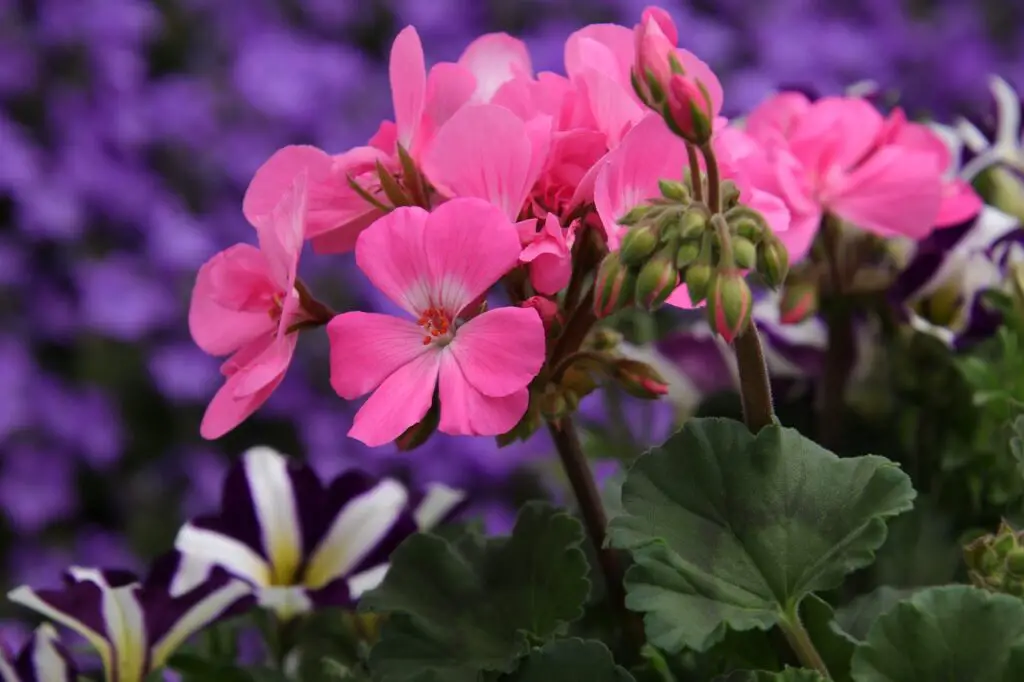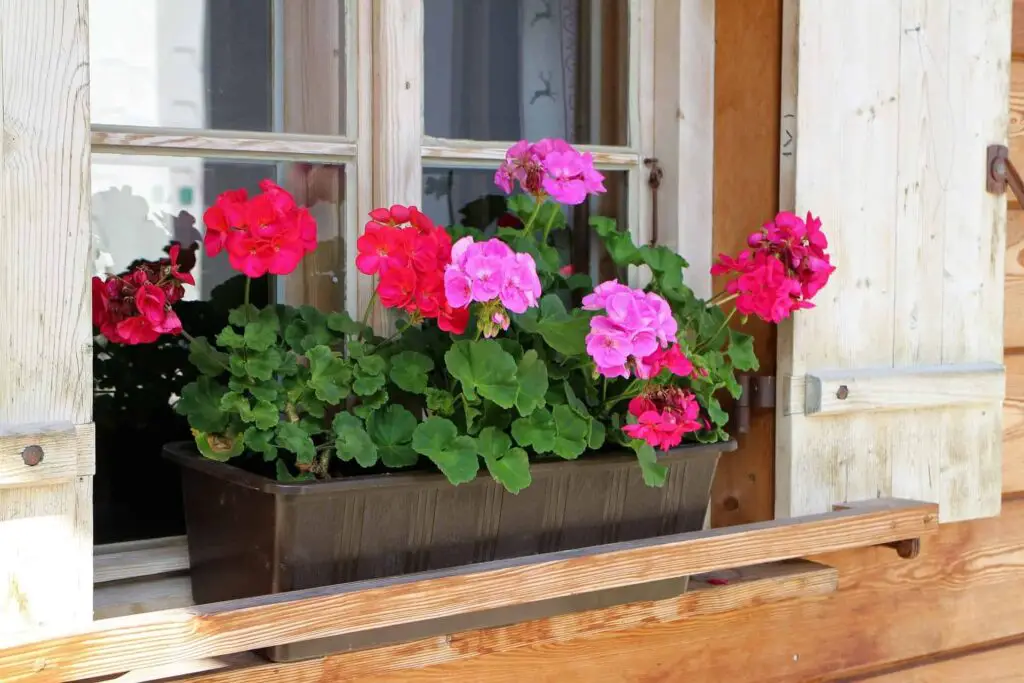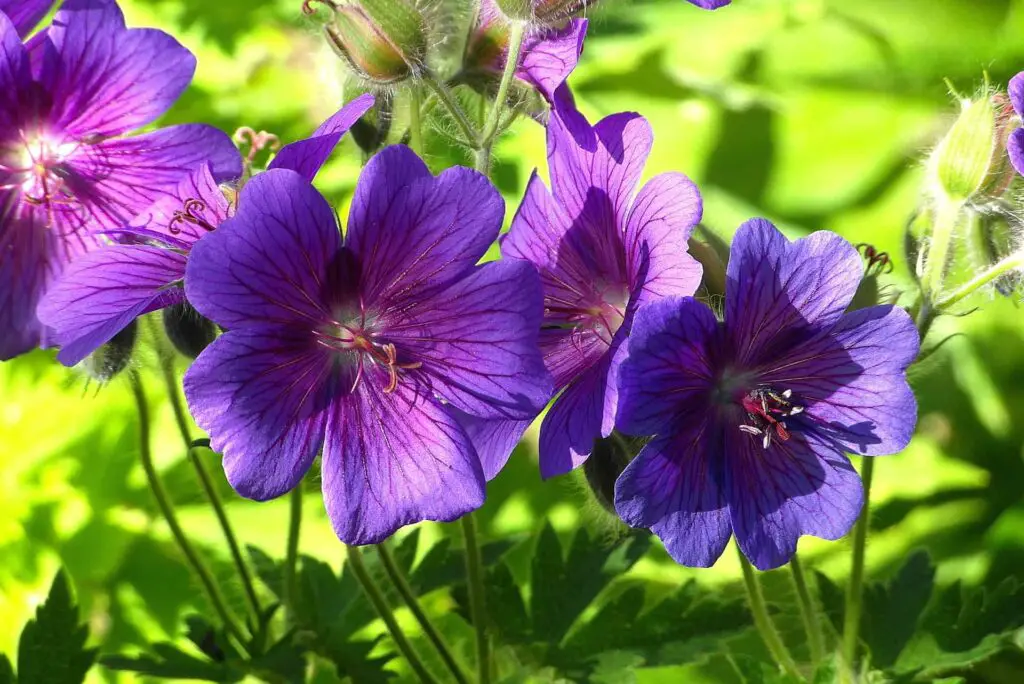Among container gardeners, geraniums are one of the most well-liked houseplants. Growing these plants is easy and rewarding, thanks to their stunning blooms that last an extended period. However, maintaining their health requires thoroughly understanding how often to water geraniums in pots.

Watering potted geraniums depends on many factors, including pot size, soil type, and temperature. When growing in a container with good drainage, geraniums need watering once a week.
During the summer, it required more frequently than once a week. Checking the soil moisture by inserting your finger about an inch deep is the most reliable method. If the soil feels dry, that means it needs to be watered.
Remember that proper watering is key to your geranium’s health and longevity. It is important to provide the soil with regular moisture and prevent it from becoming too waterlogged.
Read More :- How often do you water marigolds
Factors affecting how often to water geraniums in pots
Temperature:- Temperature affects how often to water geraniums in pots. Compared to the rainy season or winter, summer requires more regular watering.
Pot Size:- The size of your pot can impact the watering schedule. Generally, smaller pots tend to dry out quicker than larger ones, meaning you may need to water them more frequently.
Soil Type:- The type of soil also impacts your watering schedule. If you add perlite and cocopeat to your soil. It’s able to keep moisture more than normal soil. So it impacts your watering.
Humidity:- Humidity also affects how often you need to water geraniums. The soil can keep more moisture level in high humidity, so you may not need to water as often. But, the soil can dry out quickly in dry air or low humidity conditions. And need more frequent watering.
Geraniums are drought-tolerant plants, so they can survive with little negligence. But, it should never be allowed to dry out totally. So monitor your geraniums and adjust your watering schedule based on their needs.

Signs of under and over-watering geraniums in pots
Under-watering
Under-watering occurs when the soil in the pot is too dry. Geraniums can show the following symptoms when they get insufficient amounts of water:
1. Wilting leaves: When geraniums are not given sufficient water, the leaves on the plant will begin to droop and wilt.
2. Dry soil: If the soil in the pot is dry to the touch, this is a clear sign that the geraniums are not receiving sufficient water.
3. Yellowing leaves: If the leaves of the geraniums start to turn yellow and brittle. It seems like the plant is not receiving the right amount of water.
4. Stunted growth: When geraniums are under-watered, they will be stunted. The plant will not grow as tall or full as it should and may even start losing leaves.
Over-watering
Overwatering occurs when the soil in the pot is too wet. Geranium plants that have received an excessive amount of water may show the following symptoms:
1. Yellowing leaves: Like underwatering, It also course yellow leaves and becomes brittle. If they receive excessive water.
2. Mushy stems: Over-watering can cause the stems of geraniums to become soft and mushy. Which can lead to the plant’s demise.
3. Fungus growth: Too much water encourage fungus, harming geraniums.
4. Root rot: Over-watering can also lead to root rot, which can be fatal to geraniums.
The best way to understand if plants are underwater or in excess water is to track the moisture level with a moisture meter or soil moisture meter.
Tips for watering geraniums in pots

- When watering geraniums in pots. It’s best to water them from the bottom instead of pouring water onto the leaves and flowers. It helps prevent rot and fungal diseases.
- To keep the moisture intact and ensure a steady temperature, it’s recommended to add a layer of stones or mulch on the surface of the soil.
- Before you water the soil, you should check its moisture by inserting your finger into the ground about an inch deep. Water if it’s dry. Water later if it’s still wet.
- You should water the soil until it drains out of the container. This prevents the roots from drying out.
- Ensure the container has drainage holes on the bottom because stagnant water can cause root rot and other problems.
- Watering frequency depends on pot size, temperature, humidity, and plant demands. When the top of the soil feels dry , it is time to water the plant.
- Geraniums need extra water in hot, dry weather. Water less in colder or humid environments.
- It is recommended to water geraniums during morning hours for optimal plant care. This practice ensures that any surplus water on the leaves has ample time to evaporate before the evening’s cooler temperatures arrive. It reduces the risk of fungal diseases.
- Water the soil straight at the plant’s base to prevent soaking the leaves. Wet leaves increase illness risk.
Do Geraniums Like Rain?
Geraniums tolerate rain. Actuality, rain benefits all types of geraniums. But too much of it can lead to overwatering and potential root rot.
To avoid waterlogging. Plant geraniums in well-draining soil or containers with drainage holes in rainy areas. Shelter them during severe rains or transfer them under shelter. For optimal growth, geraniums require consistent and moderate watering while avoiding exposure to rain.
Do geraniums like sun or shade?
For optimal growth, geraniums at least six hours of full sun daily. But they can also grow in partial shade but may bloom less profusely. If you live in a warm region, it is advisable to offer shade during the afternoon to avoid the foliage from burning and drooping.
How do you care for potted geraniums?
Geraniums are easy to care for, maintain a proper irrigation system and give six hours of direct sunlight. To ensure the health of your plants, it is best to water them only when the top inch of soil is dry. During the spring and summer months, it is recommended to apply fertilizer every two to four weeks. Finally, prune the geraniums back by one-third in late summer or early fall. It promotes bushier growth and prepares the plant for winter dormancy.
Conclusion
We hope this post has given you a clear understanding of how often to water geraniums in pots. Although it may appear daunting initially, with a thorough understanding of the geraniums growth and nurturing process, it will become a manageable and straightforward task.

